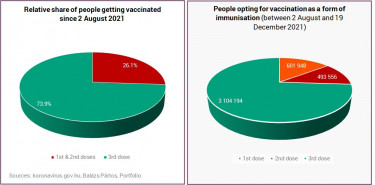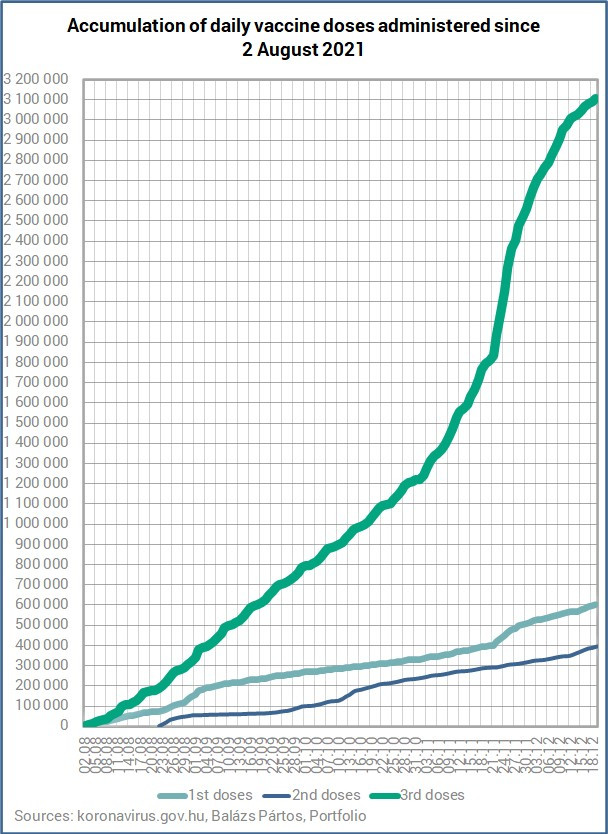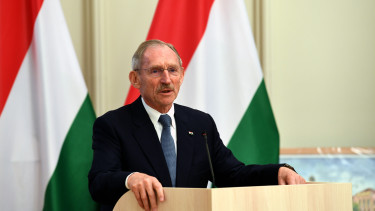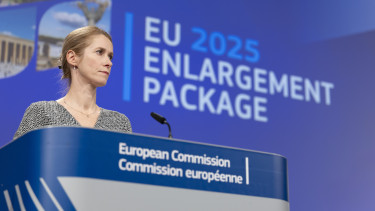COVID-19: 366 deaths in Hungary over the weekend


About the positivity rate
Several percent positive indicators show that the current 'wave' of the pandemic peaked between 9 and 14 December. When it comes to the test positivity rate the daily figures are not important because they are highly volatile. The longer-term indices peaked between 7 and 10 December. The CFR (case fatality rate, [deaths / confirmed cases] ) hit its lowest on 12 December, and it is likely to rise from then onward, at least until the Omicron variant starts to make a meaningful impact.
The 7-day average of the 3-day average / 21-day average ratio dipped under 100% on 9 December, and it is expected to keep dropping until Omicron takes over.
What is particularly odd is that the number of Covid deaths does not track any other indicator; not the number of hosplitalised Covid patients, not the number of ventilated patients, not the number of registered cases. None of these - it's a miracle, folks! Or it's not, but we will have to wait for the Central Statistical Office's (KSH) excess mortality data to find out what happened. Our strong suscpicion is that a lot of deaths are not in the statistics provided by the Coronavirus Task Force, and yet this wave has already been deadlier than the one in the autumn of 2020.



The situation in hospitals
The following charts show changes in two of the key metrics in the pandemic, the number of Covid patients in hospital and on ventilator as well as their relevant ratios.

On the charts below the 0% line is important. When the curves are under 0% there’s a decline, when they go over 0% it’s an increase. The changes show that the situation in terms of hospitalisations started to worsen after 20 August.
More importantly, when a value is north of 0% but the curve descends, it means an increase at a slowing rate, rather than a decrease. If the curve is above 0% and ascending, it is an increase at an accelerating rate. When we are under 0% and the curve goes lower, it translates into an accelerating decrease, and when it goes up it marks a decelerating decrease. These charts also give reason for optimism. All three curves are under the 0% mark and descending but at a dimishing rate.

The ratio of Covid patients on ventilator to those hospitalised has been rising, as the latter number has been dropping at a greater rate than the former. According to today's report, the number of hospitalised Covid patients was down nearly 6% over Friday and by more than 15% compared to a week ago, while the respective changes in the number of ventilated patients were 3.2% and 11%.

Here you can take a closer look at hospitalisation and ventilation data.
Although the key metrics show that the current 'wave' has peaked, the extremely rapidly spreading Omicron variant may cause dramatic changes within weeks. An increasing number of countries are announcing lockdown measures to help stem the spread of the highly contagious variant, and a subsequent strain on health care systems.


Looking at the track record of the Hungarian government we have a strong suspicion that no new restrictions will be announced any time soon. Prime Minister Viktor Orbán is set to hold a press briefing tomorrow morning. The agenda may include the following items:
- outlook on Omicron, potential responses to it;
- vaccination of children, vaccination campaigns;
- 2022 economic outlook, inflation outlook, energy prices;
- turnaround in fiscal policy;
- fiscal expenditures, major rebates for families, pensions, wage hikes;
- possible announcement of measures affecting the 2022 budget;
- EU matters, rule of law issues, EU funds.
Vaccinations, Omicron
Note that 3.1 million people have been inoculated with three doses of COVID-19 vaccines in Hungary with a population of cc. 9.8 million.
In view of various studies showing diminished effectiveness of even two doses against infection by Omicron, and the fact that the effectiveness of vaccines wanes over time regardless of the strain they have to combat, this implies that less than one third of the population has 'up-to-date' protection against coronavirus. Of course, we also take into consideration protection gained by infection, and that the effectiveness of vaccines do not wane to the same degree for everyone, but is still a dramatically low figure.



For three weeks (22 Nov - 12 Dec) Hungarians did not have to sign up and book an appointment for COVID-19 jabs. All they had to do was show up at a vaccination location and get their shot. The user-friendly administration rules initially gave quite a boost to vaccinations, but Hungarians' enthusiasm evaporated fairly rapidly, and demand for third doses remained much greater than for first and second doses combined.

Cover photo: Getty Images







